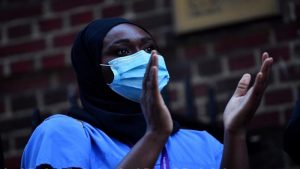07-05-2020
By SJA Jafri + Agencies
LONDON/ PARIS/ NEW YORK: Non-black people are more than four times likely to die from Covid-19 than white people, according to stark official figures exposing a dramatic divergence in the impact of the coronavirus pandemic in England, Wales and many other countries while other ethnic minority groups also worse affected, researchers, victims, Covid-19 patients and sources claimed.
The Office of National Statistics found that the difference in the virus’s impact was not only caused by pre-existing differences in communities’ wealth, health, education and living arrangements.
It discovered that after taking into account age, measures of self-reported health and disability and other socio-demographic characteristics, black people were still almost twice as likely as white people to die a Covid-19-related death.
 Bangladeshi and Pakistani males were 1.8 times more likely to die from Covid-19 than white males, after other pre-existing factors had been accounted for, and females from those ethnic groups were 1.6 times more likely to die from the virus than their white counterparts.
Bangladeshi and Pakistani males were 1.8 times more likely to die from Covid-19 than white males, after other pre-existing factors had been accounted for, and females from those ethnic groups were 1.6 times more likely to die from the virus than their white counterparts.
The risk of Covid-19 death for people from Chinese and mixed ethnic groups was found to be similar to that for white people.
“These results show that the difference between ethnic groups in Covid-19 mortality is partly a result of socio-economic disadvantage and other circumstances, but a remaining part of the difference has not yet been explained,” the ONS said.
Guardian research last month confirmed suspicions that minority groups faced the greatest risk from the coronavirus and showed that areas with high ethnic minority populations in England and Wales tended to have higher mortality rates during the pandemic so far.
Zubaida Haque, the deputy director of the Runnymede Trust race equality thinktank, described the findings as “alarming”.
“We cannot ignore how important racial discrimination and racial inequalities (e.g. in housing) are, even among poorer socio-economic groups,” she said. “These factors are important but are not taken into account in most statistical modelling of Covid-19 risk factors.”
While only 2% of white British households experienced overcrowding from 2014 to 2017, 30% of Bangladeshi households, 16% of Pakistani households and 12% of black households experienced this, according to a study of the English Housing Survey. These groups are more likely to work in frontline roles in the NHS in England, where nearly 21% of staff are non-white, compared with about 14% of the population of England and Wales. Black, Bangladeshi and Pakistani populations have been shown to face higher levels of unemployment and child poverty than white groups.
 Helen Barnard, the acting director of the Joseph Rowntree Foundation, said the findings were “a stark reminder that although we are all weathering the same storm, we are not all in the same boat”.
Helen Barnard, the acting director of the Joseph Rowntree Foundation, said the findings were “a stark reminder that although we are all weathering the same storm, we are not all in the same boat”.
“With the Bank of England now forecasting the deepest recession on record, we must ask ourselves what kind of society we want to live in after the virus passes,” she said. “It doesn’t have to be like this – as a society that prides itself on justice and compassion we can and must do better.”
The figures, covering deaths from 2 March to 10 April, are the first official snapshot of the way that Covid-19 has affected different ethnic groups in England and Wales. They follow widespread concern that pre-existing health inequalities between black and minority ethnic populations – particularly in relation to cardiovascular disease and diabetes – are being amplified during the pandemic.
To try and understand how much of the difference in Covid-19 morbidity was to do purely with ethnicity, the statisticians adjusted for age as well as region, rural and urban classification, area deprivation, household composition, socio-economic position, highest qualification held, household tenure, and health or disability in the 2011 census.
“The fully adjusted results show differences in risk between ethnic groups that are specific to those ethnic groups and are not caused by any of the factors listed on which members of the groups might differ,” the ONS concluded.
After all these factors were accounted for, Indian men and women were less likely than people from Bangladeshi and Pakistani background to die from Covid-19, but were still 1.3 times and 1.4 times more vulnerable than white people.
Chinese women were the only group to be less vulnerable than white people, after adjusting for other differences, while Chinese men were 1.2 times more likely to die from the disease than white people.
The ONS also checked to see if, within ethnic groups, socio-economic class made a difference. They found that the differences in risk of Covid-19-related death across ethnic groups were of similar magnitudes within all three socio-economic classes.
The differences in the risk of dying from Covid-19 could be driven by factors not included in its model, the ONS acknowledged.
Some groups may be over-represented in public-facing occupations and could be more likely to be infected by Covid-19. The ONS said it plans to conduct further work to identify occupations that are particularly at risk.
 Pressmediaofindia
Pressmediaofindia




